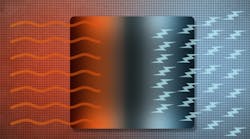Research at the University of Michigan funded by RDECOM Research Laboratory is showing that heat, in addition to sunlight, can be an effective source of electricity. The investigation has focused on making fundamental improvements to traditional thermophotovoltaic (TPV) approaches to transforming heat to electricity to provide soldiers with the flexibility of different energy sources in the field, such as sunlight during the day and heat at night. The main problem to overcome has been the low efficiency in converting heat sources to electricity, a challenge taken on by the researchers through the application of nanoscale engineering.
In a photovoltaic cell, photons (light) is converted to electrical energy. In a thermophotovoltaic cell, heat energy from a hot or heated source that is transferred to a colder object can be converted to electrical energy. This occurs as part of a process in which photons tunnel through the bandgap of a thermophotovoltaic cell, a process also known as near-field radiative heat transfer. The research discoveries occurred as the result of exploring various nanoscale two-dimensional structures and two-dimensional materials, such as graphene, capable of supporting the transfer of heat and conversion to electricity. The thermophotovoltaic work was funded by the Army Research Office, the U.S. Department of Energy Basic Energy Sciences, and the National Science Foundation. The RDECOM Research Laboratory is the parent organization of the Army Research Office.
Advances were reported by Professors Pramod Reddy and Edgar Meyhofer from the Mechanical Engineering Department of the University of Michigan along with graduate students and postdoctoral fellows Dr. Anthony Fiorino, Dr. Linxiao Zhu, Dakotah Thompson, and Rohith Mittapally. “Our work clearly demonstrates that performance of thermophotovoltaic devices that employ a photovoltaic cell and a hot object as an emitter can be dramatically enhanced,” Meyhofer said.
“Unlike traditional photovoltaic technologies, thermophotovoltaic devices do not rely on sunlight for generating power,” Fiorino added. “They can use any source of heat. This makes them particularly well-suited for generating power at night or even indoors, and they can even be made portable for generation in remote locations.”

